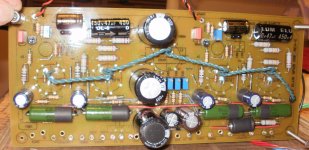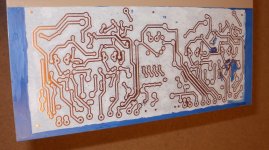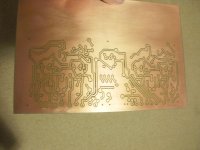It is electro-less tin plate liquid:
421-500ML MG Chemicals Solder, Fluxes & Accessories
Just steel wool the copper to be bright, remove any steel wool residue then drop into a ziplock bag with liquid tin and agitated for 5 minutes. I've been using the same stuff for over a yr now and it still does a quick plate. about $35.......
421-500ML MG Chemicals Solder, Fluxes & Accessories
Just steel wool the copper to be bright, remove any steel wool residue then drop into a ziplock bag with liquid tin and agitated for 5 minutes. I've been using the same stuff for over a yr now and it still does a quick plate. about $35.......
I've been using HP LASER PRESENTATION PAPER, Q2546A with good success. By using max ground plane, there is minimum etch area so it lasts longer. I always tin plate to protect the copper.
Hello Roline
Is the board in your post single or double sided? If it is Double sided would you share your total technique with us, I am working on a double sided project my self...
Thanks
I know this is an old thread, but I thought I would tell people about the recent paper I have just used. I used to use an Epson photo paper that transferred well and when soaked in soapy water would peal off in a matter of seconds. They stopped selling this paper, and after running out of it recently, I ordered some of this:
http://www.amazon.co.uk/Epson-Premi...PMZ4/ref=sr_1_2?ie=UTF8&qid=1361477631&sr=8-2
Epson Premium Golssy Photo paper - S042167
It transferred well, and after a 30 minute soak, you can gently peal the paper away. I am very pleased with the final results of the boards after etching.
http://www.amazon.co.uk/Epson-Premi...PMZ4/ref=sr_1_2?ie=UTF8&qid=1361477631&sr=8-2
Epson Premium Golssy Photo paper - S042167
It transferred well, and after a 30 minute soak, you can gently peal the paper away. I am very pleased with the final results of the boards after etching.
The only way that I know of doing a double sided PCB is to align the artwork through drilled alignment holes. I have not been happy with the results (soldering the leads on both sides, alignment on both sides, etc...) so I have just been doing single sided with ground plane jumpers" stitching" the ground plane together to minimize possible ground loops. I will also add wire jumpers e.g. for bias lines (blue) and pentode 160volt reference(red).
I always add the twisted heater wires running them at least 1/2" off of the PCB to minimize coupling. Where I anticipate multiple wires being installed and reinstalled I will use brass eyelets for durability.
I always add the twisted heater wires running them at least 1/2" off of the PCB to minimize coupling. Where I anticipate multiple wires being installed and reinstalled I will use brass eyelets for durability.
Attachments
Last edited:
I know this is a little late, but could you tell us more about the silver plate solution that you use?
I use tinplate myself, from chemicals bought off of ebay, and while it plates quite well if you solder the PCBs right away, they don't have a long shelf life. Typical of tinplating, the traces start getting difficult to solder after awhile.
Thanks.
The only way that I know of doing a double sided PCB is to align the artwork through drilled alignment holes. I have not been happy with the results (soldering the leads on both sides, alignment on both sides, etc...)
Instead of alligning the holes, it is better to position them away and connect like jumpers which don't need to be alligned.
Gajanan Phadte
I'm not a fan if Tinnit as it needs to be heated to 60 deg C (AFAIR) in order to work. MG Chemicals Liquid Tin works at room temperature. The tin plating created by the Liquid Tin is generally pretty good, though, lately I've been having some issues getting it to plate evenly. Perhaps because the bottle I have is near the end of its useful life.
The best product I've used is still Kontakt Chemie Lötlack SK10. It's a form of conformal coating that contains flux. It protects the PCB from oxidation and you can solder through the coating. I haven't seen it at any of the US component distributors, but it's available in (Northern) Europe.
~Tom
The best product I've used is still Kontakt Chemie Lötlack SK10. It's a form of conformal coating that contains flux. It protects the PCB from oxidation and you can solder through the coating. I haven't seen it at any of the US component distributors, but it's available in (Northern) Europe.
~Tom
HCL = hydrochloric acid.
H2O2 = hydrogen peroxide.
Andrew,
Big Thanks
Is it 2 part of H202 and 1 part HCL ?
Albert
Andrew,
Big Thanks
Is it 2 part of H202 and 1 part HCL ?
Albert
Hi Albertli,
I use HCl 23% from the supermarket, and H2O2 from the pharmacist, but the one much more concentrated he uses to produce the normal H2O2 that is sold to people, the concentrated H2O2 is sold in bottles of 1 liter : it is not the common H2O2 you find in the supermarket, and it is not very cheap either.
Here are the quantities I use : 2x 60ml H2O + 15ml H2O2 + 30 ml HCl. I am able to etch quickly (in less than 5') a board like 10cm x 16cm at room temperature.
You should give it a try, and adjust the quantity of acid with the dimensions and the number of the boards you want to etch.
Watch this : the concentrated H2O2 is very
 and advertise
and advertise  with respect your wife !
with respect your wife !You dispose easily of the used etchant with sodium bicarbonate sold by your pharmacist, speak to him to get a cheap big quantity : he must use good bicarbonate for people, and after a while he must dispose of the old one ... The pharmacist is my friend
Using bicarbonate, beware that it produces big
Don't forget the necessary good quality tool after having etched your board
 .
.I hope this helps
Best regards
rephil
Tin Plate is what is used on tin cans to stop corrosion affecting the food contained therein, for more than decades.I know this is a little late, but could you tell us more about the silver plate solution that you use?
I use tinplate myself, from chemicals bought off of ebay, and while it plates quite well if you solder the PCBs right away, they don't have a long shelf life. Typical of tinplating, the traces start getting difficult to solder after awhile.
Thanks.
Tin is very resistant to corrosion.
If your "tin plating" is going off "after awhile", then I suspect you are not applying a coating of Tin (Sn) to your boards/pads.
Actually degradation of tin plating is well documented. See this for example this article from Tyco: http://www.te.com/documentation/whitepapers/pdf/Keeping_Tin_Solderable.pdf
It leads with: "Tin plating on a component lead makes its soldering easier. Everybody knows that. Not so well known is that tin plating has shelf life -- its ability to be easily soldered degrades over time. The speed and severity of degradation depends both on storage conditions and on the plating itself."
Another document that addresses the issue:
http://www.ipc.org/TOC/IPC-4554.pdf
In my experience the Tinnit plating degraded very quickly. My homebrew solution did significantly better. I suspect that in both instances the plating layer is too thin for extended shelf life.
It leads with: "Tin plating on a component lead makes its soldering easier. Everybody knows that. Not so well known is that tin plating has shelf life -- its ability to be easily soldered degrades over time. The speed and severity of degradation depends both on storage conditions and on the plating itself."
Another document that addresses the issue:
http://www.ipc.org/TOC/IPC-4554.pdf
In my experience the Tinnit plating degraded very quickly. My homebrew solution did significantly better. I suspect that in both instances the plating layer is too thin for extended shelf life.
Hi Albertli,
I use HCl 23% from the supermarket, and H2O2 from the pharmacist, but the one much more concentrated he uses to produce the normal H2O2 that is sold to people, the concentrated H2O2 is sold in bottles of 1 liter : it is not the common H2O2 you find in the supermarket, and it is not very cheap either.
Here are the quantities I use : 2x 60ml H2O + 15ml H2O2 + 30 ml HCl. I am able to etch quickly (in less than 5') a board like 10cm x 16cm at room temperature.
You should give it a try, and adjust the quantity of acid with the dimensions and the number of the boards you want to etch.
Watch this : the concentrated H2O2 is veryactive on your skin ... pay attention to this. Keep the concentrated H2O2 at low temperature (mine is located in my refrigerator.) Pay attention to children
and advertise
with respect your wife !
You dispose easily of the used etchant with sodium bicarbonate sold by your pharmacist, speak to him to get a cheap big quantity : he must use good bicarbonate for people, and after a while he must dispose of the old one ... The pharmacist is my friend... so I have very cheap old bicarbonate in big quantity.
Using bicarbonate, beware that it produces bigbubbles in the acid. Using it, you will get a precipitate of a Cu salt that is inert, and you may throw it in the bin. I throw the "water" (above the blue precipitate) that should be water + NaCl away, and I let evaporate the remaining with time, so I throw crystals and powder in the bin.
Don't forget the necessary good quality tool after having etched your board.
I hope this helps
Best regards
rephil
rephil,
Big thanks and I know where to start.
Albert
I would also be curious about the silver plating, however, I'm quite certain that it has it's own issues. I once saw an amplifier that had been built years ago, and had been soldered with silver solder. Every joint on it was black; a real mess!
I use "Tinnit" to plate board traces, and also found some difficulty with soldering. The problem, I discovered was that I didn't leave it in the plating solution long enough, and at a high enough temperature. I now heat the solution to about 160F (higher temperatures increase the activity of the solution), and for the recommended 20-30 minutes. Originally, I saw the color change that occurs within 5 minutes, and figured that it was "good enough". It isn't. The increased plating depth significantly improves solderability.
I use "Tinnit" to plate board traces, and also found some difficulty with soldering. The problem, I discovered was that I didn't leave it in the plating solution long enough, and at a high enough temperature. I now heat the solution to about 160F (higher temperatures increase the activity of the solution), and for the recommended 20-30 minutes. Originally, I saw the color change that occurs within 5 minutes, and figured that it was "good enough". It isn't. The increased plating depth significantly improves solderability.
I think I will try warming the solution and leaving it in longer. I have been using it at room temperature and taking it out five minutes or so after the color change. Incidentally, the solution I use, which I found on the homebrew PCB Yahoo Group has been kicking around on the internet for several years now, and is as follows:
• 0.5g Stannous Chloride
• 2.0g Thiourea
• 3.0g Sulfamic Acid
• 100.0 mL Distilled water
And it does give good results. Shelf life isn't a problem because I mix up each batch as I need it.
Thiourea apparently comes with some risks, so caveat emptor. I use it with gloves and a breathing mask (that I also use for finishing projects) and in a well ventilated area. But most chemicals used to make PCBs should be handled with care anyway.
• 0.5g Stannous Chloride
• 2.0g Thiourea
• 3.0g Sulfamic Acid
• 100.0 mL Distilled water
And it does give good results. Shelf life isn't a problem because I mix up each batch as I need it.
Thiourea apparently comes with some risks, so caveat emptor. I use it with gloves and a breathing mask (that I also use for finishing projects) and in a well ventilated area. But most chemicals used to make PCBs should be handled with care anyway.
Concerning H2O2:
You can buy 3% peroxide at WalMart and other suppliers dirt cheap, but higher concentrations are considerably more expensive. It's quite easy to concentrate it yourself by boiling since water boils at 212F and H2O2 about 350F. The process simply involves heating the peroxide to the point that bubbles and mist appears, and let it go until a 50% volume reduction is achieved (for 6% solution).
There is a video somewhere on YouTube that shows the simple process.
Keep your H2O2 in a closed bottle, and as full as practical, since peroxide quickly gives up its extra oxygen molecule, and looses strength, eventually turning back to plain water.
You can buy 3% peroxide at WalMart and other suppliers dirt cheap, but higher concentrations are considerably more expensive. It's quite easy to concentrate it yourself by boiling since water boils at 212F and H2O2 about 350F. The process simply involves heating the peroxide to the point that bubbles and mist appears, and let it go until a 50% volume reduction is achieved (for 6% solution).
There is a video somewhere on YouTube that shows the simple process.
Keep your H2O2 in a closed bottle, and as full as practical, since peroxide quickly gives up its extra oxygen molecule, and looses strength, eventually turning back to plain water.
- Status
- This old topic is closed. If you want to reopen this topic, contact a moderator using the "Report Post" button.
- Home
- Design & Build
- Construction Tips
- Toner Transfer Paper Problems


